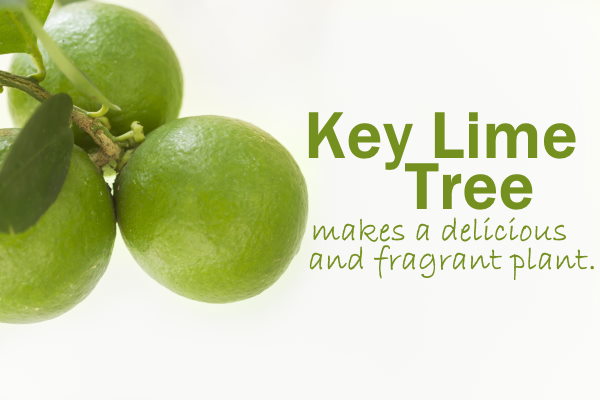Dwarf Key Lime Tree
If you have a sunny spot for it, Key Lime Tree makes an easy house plant that will bear flowers and fruit off and on year-round.
Known botanically as Citrus aurantifolia, dwarf key lime makes an unusual and aromatic indoor tree. With this guide, you'll discover how much light it wants, when to repot, why you'll want to prune your fruit tree, and much more.
 © Creative Commons Zero (CC0)| Dreamstime.com
© Creative Commons Zero (CC0)| Dreamstime.comGet to Know Key Lime Tree
Glossy, oval leaves growing on spiny stems are typically accompanied by white, star-shaped flowers. Those blooms are tiny -- each 4 or 5 petal bloom is no bigger than a 1/2 -inch (12 mm) wide -- but sweetly scented and will bloom in abundance.
Flowers are followed by 2-3 in (5-7.5 cm) round, green limes. Key lime fruit is smaller than the more common Persian lime (Citrus x latifolia). Key limes are also more acidic and tart, best known as the flavoring in Key Lime Pie.
Given enough light, you can expect flowers and fruit on the tree at the same time, making this citrus tree a delightful, fragrant house plant.
Where do these fruit trees come from? They are native to Southeast Asia.
How big does key lime tree get? You can expect this dwarf citrus tree to reach a height of 3-5 ft (90cm - 1.5m), grown in a container indoors.
How long does it take for dwarf key lime trees to bear fruit? Mature trees will produce fruit in about 2 to 3 years.
Problems, Solutions and Answers
Got blooms, but no fruit? It probably needs pollinated. Fruit trees grown outdoors are pollinated from the wind or insects that carry the pollen from flower to flower. If you've kept your key lime tree indoors, it needs some help from you. Don't worry -- it's easy to do. To pollinate your dwarf citrus tree, use a small paintbrush to dab the stamens in the center of the flowers, moving from flower to flower to spread the pollen around.
Dropped flowers are sometimes caused by dry indoor air. The most efficient way to raise the humidity for houseplants is to place a room humidifier near your plant. See "Humidity" tips below.
Prune your plant. Pruning lime trees will keep them shapely -- and compact. You'll also encourage more flower buds to form. Prune in spring, removing old wood and long side branches. Once you get in the habit of yearly pruning, it's hardly any work at all.
Repot in spring. Repot only when the roots have filled the pot. Move to a pot only 1 size larger. Why? A pot that's too large will hold too much water. Use a pot with a drainage hole to prevent overwatering, which can cause root rot. Also, plants bloom best when their roots are a little snug in the container.
Yellow leaves? A lack of iron causes yellowing of leaves. Don't forget to feed your fruit tree. See "Fertilizer" below.
Something bugging your plant? Check your houseplants regularly for aphids. They tend to hang out on flower buds and stems. Other possible pests are scale and mealybugs. If you find an infestation, treat your plant right away because these little pests can harm your plants.
Key Lime Buying Tip
I recommend buying a dwarf key lime tree for growing in a container. Buy a named cultivar from a reputable grower to ensure a quality, long-lasting plant that will produce fruit.
Key Lime Tree Care
Light: Plants that don't bloom aren't getting enough light. Put your lime citrus tree where it will get bright light with at least 6 hours of direct sunlight every day. Moving your lime tree outdoors to the patio for the summer is ideal. Just be sure to bring it back indoors if the temperature dips to 50°F/10°C at night.
Water: Keep soil evenly moist, but not soggy. Constantly wet soil may cause root rot. Water thoroughly to wet all the roots, then allow the top 2 inches (5 cm) to dry out before watering again.
Humidity: Aim to maintain 40% relative humidity or higher. If indoor air is dry, use a cool-mist room humidifier. It's a good idea to keep your citrus tree away from heat/AC vents, which will affect humidity and temperature.
Temperature: Normal room 65-75°F/19-24°C. If you move your key lime tree outdoors for the warm months, don't worry -- it can take the heat. Bring it back inside when the nighttime temperature drops to 50°F/10°C. This tropical citrus plant doesn't like the cold and won't tolerate frost.
Soil: Light, fast-draining medium, such as peat moss-based potting mix
Fertilizer: Feed every 2 weeks spring through fall. I highly recommend organic citrus tree fertilizer. It contains all the nutrients citrus trees need for healthy root growth and promotes flowers and fruits.
Propagation: Take 4 in (10 cm) stem tip cuttings in early summer. Dip cut ends in rooting powder, then insert them into moist potting mix. Enclose the cutting and container in a plastic bag or cover with a glass cloche to maintain high humidity. Cuttings should root in about 6-8 weeks.
Seeds taken from lime fruits will grow, but are unlikely to produce fruit.


